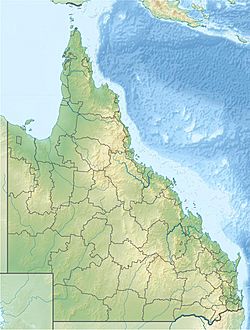Booby Island Light facts for kids
 |
|
| Booby Island Lighthouse and one of the deteriorated cottages | |
|
|
|
| Location | Booby Island Queensland Australia |
|---|---|
| Coordinates | 10°36′20″S 141°54′33″E / 10.60556°S 141.90917°E |
| Year first constructed | 1890 |
| Automated | 1992 |
| Construction | timber frame clad with galvanised iron |
| Tower shape | conical tower with balcony and lantern |
| Markings / pattern | white tower and red dome |
| Height | 59 feet (18 m) |
| Focal height | 121 feet (37 m) |
| Range | 20 nautical miles (37 km; 23 mi) |
| Characteristic | Fl W 10s. |
| Admiralty number | K3274 |
| NGA number | 111-9620 |
| ARLHS number | AUS-011 |
The Booby Island Light is an important lighthouse in Australia. It stands on Booby Island, which is near the very top of Queensland. This lighthouse helps guide ships safely through the western part of the Torres Strait. It was one of the last big lighthouses built along the Queensland coast. Today, it is a heritage-listed site.
Contents
History of the Booby Island Light
Queensland became a colony in 1859. In 1862, George Poynter Heath became the first Portmaster. This job meant he was in charge of ports and shipping. Heath was the first to suggest building a lighthouse on Booby Island. He made this suggestion in 1873 at a meeting about marine departments.
However, the idea was not acted upon right away. In 1885, Heath brought up the idea again. This was because more ships were using the Torres Strait. A new shipping route had also been set up. It took four more years for the plan to be officially approved.
Building the Lighthouse
In April 1899, people were asked to bid on building the lighthouse. The Rooney brothers, John and Jacob, won the bid. They were from Maryborough. They had also built several other lighthouses in Queensland.
The Booby Island Light first shone on June 24, 1890. The total cost to build it was about £6,500. Homes for the lighthouse keepers were also built in 1890.
Changes Over Time
The lighthouse first used a special lens called a Fresnel lens. This lens was made by Chance Brothers. It sat on a spinning base that used mercury to help it turn smoothly. The light came from an oil lamp. It was as bright as 20,000 candles.
In 1917, the light was made much brighter. It was upgraded to use vaporised kerosene. This made the light as bright as 120,000 candles.
In 1961, a radio beacon was added. This helped ships find their way using radio signals. In 1963, the lighthouse changed to use electricity. The light became even brighter, like 1,000,000 candles. It could be seen from about 26 nautical miles away. At this time, the light flashed once every four seconds. A device to measure tides was also put in place in 1970.
Automation and Modernisation
In November 1991, the lighthouse was changed to run on solar power. The old lens and its mercury base were removed. They were replaced with a modern spinning system. The original lens is now in the Thursday Island Museum. Large batteries were put in the bottom of the tower.
The light's flash pattern was changed. It now flashes white once every ten seconds. It can be seen from 20 nautical miles away. In 1992, the lighthouse became fully automated. This means it runs by itself and no longer needs people living there.
Structures on Booby Island
The lighthouse tower is shaped like a cone. It is about 18 meters (59 feet) tall. It is made of a timber frame covered with galvanised iron. The top of the tower has the original lantern room. This room is about 10 feet wide. The tower is painted white, and its dome is red. A weather vane sits on top of the dome.
Homes for Keepers
There were four homes for the lighthouse keepers. Three were for the main keepers, and one was for a relief keeper. The main keeper homes were built in 1890. They were updated in the 1920s and 1960s. These homes have timber frames and are covered with weatherboards. There is also a glasshouse nearby. The relief quarters were built later, in the late 1960s or early 1970s.
Other Buildings
Other buildings at the station include:
- A radio equipment building, which also served as an office.
- A powerhouse with a fuel storage area. This building has three diesel generators that power the station.
- The tide gauge hut, built in 1970.
- A radio beacon transmitter building, built in 1961.
- A workshop.
These buildings are made from different materials like timber, concrete blocks, and metal sheeting.
Visiting the Booby Island Light
The Booby Island Light is operated by the Australian Maritime Safety Authority. The land around it is managed by the Queensland Parks and Wildlife Service.
You can only reach Booby Island by boat. You also need a special permit to land on the island. Both the lighthouse tower and the island itself are closed to the public.
Heritage Listing
The Booby Island Light was added to the Queensland Heritage Register in 1998. This means it is an important historical site that needs to be protected.
Images for kids





